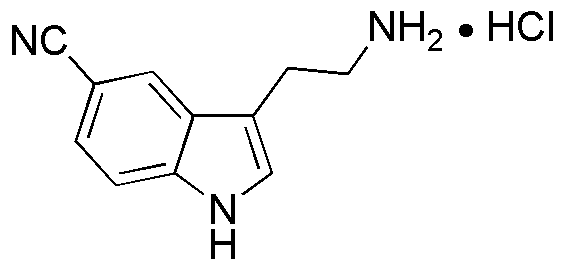5-Cyanotryptamine hydrochloride is widely utilized in research focused on:
- Neuroscience Research: This compound is studied for its potential effects on neurotransmitter systems, particularly in understanding mood disorders and neurodegenerative diseases.
- Pharmaceutical Development: It serves as a building block in the synthesis of novel pharmaceuticals, particularly those targeting serotonin receptors, which are crucial for treating various mental health conditions.
- Biochemical Assays: Researchers use it in assays to evaluate the activity of enzymes and receptors, providing insights into cellular signaling pathways.
- Drug Discovery: The compound is explored for its potential as a lead compound in the development of new drugs, especially in the field of psychopharmacology.
- Analytical Chemistry: It is employed in analytical methods to detect and quantify related compounds, aiding in quality control and research applications.
General Information
Properties
Safety and Regulations
Applications
5-Cyanotryptamine hydrochloride is widely utilized in research focused on:
- Neuroscience Research: This compound is studied for its potential effects on neurotransmitter systems, particularly in understanding mood disorders and neurodegenerative diseases.
- Pharmaceutical Development: It serves as a building block in the synthesis of novel pharmaceuticals, particularly those targeting serotonin receptors, which are crucial for treating various mental health conditions.
- Biochemical Assays: Researchers use it in assays to evaluate the activity of enzymes and receptors, providing insights into cellular signaling pathways.
- Drug Discovery: The compound is explored for its potential as a lead compound in the development of new drugs, especially in the field of psychopharmacology.
- Analytical Chemistry: It is employed in analytical methods to detect and quantify related compounds, aiding in quality control and research applications.
Documents
Safety Data Sheets (SDS)
The SDS provides comprehensive safety information on handling, storage, and disposal of the product.
Product Specification (PS)
The PS provides a comprehensive breakdown of the product’s properties, including chemical composition, physical state, purity, and storage requirements. It also details acceptable quality ranges and the product's intended applications.
Certificates of Analysis (COA)
Search for Certificates of Analysis (COA) by entering the products Lot Number. Lot and Batch Numbers can be found on a product’s label following the words ‘Lot’ or ‘Batch’.
*Catalog Number
*Lot Number
Certificates Of Origin (COO)
This COO confirms the country where the product was manufactured, and also details the materials and components used in it and whether it is derived from natural, synthetic, or other specific sources. This certificate may be required for customs, trade, and regulatory compliance.
*Catalog Number
*Lot Number
Safety Data Sheets (SDS)
The SDS provides comprehensive safety information on handling, storage, and disposal of the product.
DownloadProduct Specification (PS)
The PS provides a comprehensive breakdown of the product’s properties, including chemical composition, physical state, purity, and storage requirements. It also details acceptable quality ranges and the product's intended applications.
DownloadCertificates of Analysis (COA)
Search for Certificates of Analysis (COA) by entering the products Lot Number. Lot and Batch Numbers can be found on a product’s label following the words ‘Lot’ or ‘Batch’.
*Catalog Number
*Lot Number
Certificates Of Origin (COO)
This COO confirms the country where the product was manufactured, and also details the materials and components used in it and whether it is derived from natural, synthetic, or other specific sources. This certificate may be required for customs, trade, and regulatory compliance.


